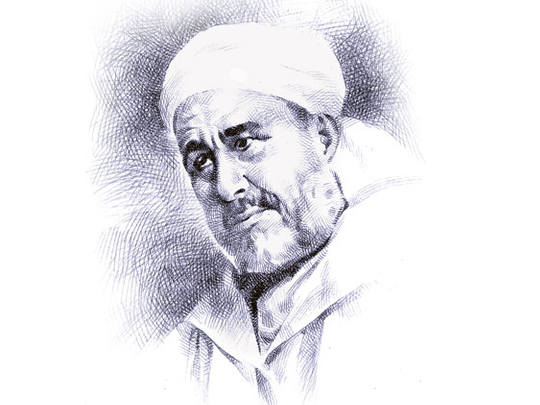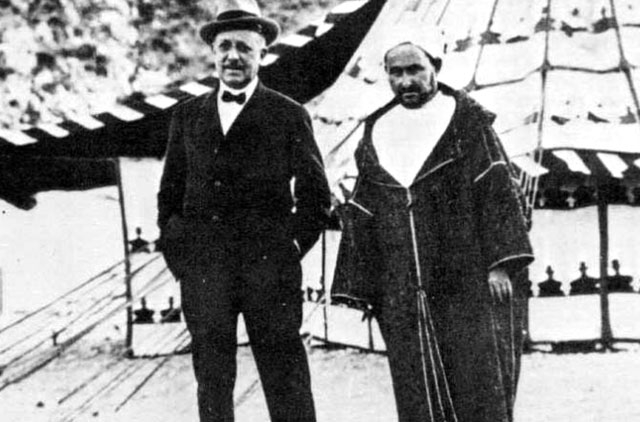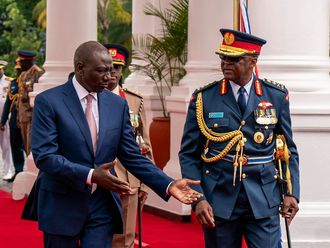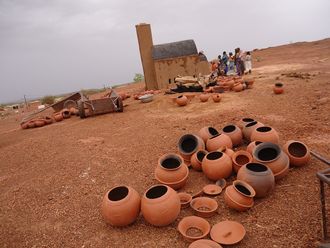
At a time of significant upheavals throughout the Arab world that surprises observers even if history is replete with instances that illustrate how such opposition develops, the case of Mohammad Bin Abdul Karim Al Khattabi (also spelt Abdul Krim Al Khatabi) stands out, especially because his guerrilla tactics against French and Spanish colonial rule in Morocco influenced Ho Chi Minh, Mao Zedong and Che Guevara, among others.
One of the great anticolonial fighters of the 20th century, Al Khattabi made the cover of Time magazine on August 17, 1925, led a successful armed resistance movement in the Rif, a Berber area of northern Morocco, and helped seal his country's independence from France on April 7, 1956, the day when Paris officially relinquished its protectorate. He was, by every stretch of the imagination, the father of guerrilla warfare against usurpers of power.
Rise to prominence
Coming from the modest town of Ajdir, Al Khattabi redefined what it meant to be a Berber in the Rif region. Berbers, descendants of the Vandals and the Semites, stand out for their courage and while many collaborated with occupying powers over the centuries, they seldom relinquished the quest for independence.
At the end of the 19th and the early 20th centuries, the Spanish introduced several expansion programmes to control the Rif's mineral resources by building a series of small forts and blockhouses, all supported from garrisons in the Presidios and other coastal towns that were under their control.
These fortifications were regarded with some, but not total, indifference by local tribes, many of whom benefited from business ties that permitted subsistence and even minimum prosperity.
Still, from time to time, local tribesmen engaged the Spanish, even if the disturbances were minor.
Because he was the son of a qadi (judge) of the Aith Waryaghal tribe, who had carefully developed relationships with the mining companies seeking to exploit the iron deposits in the Rif, Al Khattabi received a good education both in traditional schools and in Spanish institutions.
With near native fluency in the language, the young man — and his brother Mohammad, who became the first Rifi to study at university, undertaking a course in Madrid with the object of becoming a mining engineer — attended and graduated from the University of Al Karaouine in Fez.
As a journalist with the Melilla newspaper Al Teleqrama del Rif, he promoted secularism and cooperation with Westerners as a means to free the Muslim Ummah from ignorance and underdevelopment.
Although envious opponents perceived him as a shrewd fellow who had elevated himself to unprecedented heights by the use of European-style roguery, Al Khattabi became one of the leaders of a widescale armed resistance movement against French and Spanish colonial rule in northern Africa.
The young man travelled to Madrid around 1915, where he spent three years studying mining and military engineering, all with the dedicated purpose of learning how to defend his land.
Named Judge in Melilla in 1915, Al Khattabi gradually rejected Spanish control, was imprisoned in 1917 for declaring that Spain should leave the Rif and may have even expressed pro-German sympathies during the First World War.
In 1919 he escaped from prison and returned to Ajdir where, with his brother's assistance, he started to unite various tribes demanding independence.
A surge in nationalism
The surge of nationalist sentiment and the late independence of Morocco (1956) produced a change in the interpretation of the country's recent history, although there is near unanimity that events throughout the 1920s changed the country for the better.
Even if Al Khattabi could not be considered a full-blown modern politician, he was nevertheless a leader who resisted European domination. In fact, his actions in what came to be known as the Rif Revolt quickly led him to become the leader of an opposition movement, before earning him the iconic title of leader of independence movements fighting colonialism.
The Rif Revolt
The Rif Revolt, certainly one of the more remarkable episodes for self-determination by a people bearing the yoke of colonialism, seldom makes it into general history texts, primarily because it failed to achieve its goal — independence. Still, between 1921 and 1926, it left an unmistakable mark on international affairs.
In their attempts to destroy a local chieftain by the name of Raisuli in 1921, Spanish troops skirted vacant sections of the Rif that were, until then, spared military incursions. Al Khattabi warned General Manuel Fernández Silvestre that his troops should not cross the River Amekran, which he would consider an act of war.
Fernández Silvestre dismissed the message in a moment of folly and, instead, defied Al Khattabi by installing a military post on the river near the Abarrán hamlet.
In the first skirmish, Temsamani and Tuzuni tribal elements loyal to Al Khattabi attacked and killed 179 of the 300 occupiers, with the rest of the garrison in flight. Additional battles ensued, which led Fernández Silvestre to commit nearly 3,000 men, although Al Khattabi defeated the assembled force within two days.
For Spain, the battle at Anual (or Anoual) was a disaster. By the time a ceasefire was reached, an estimated 16,000 soldiers were dead and 24,000 wounded, 150 cannons were destroyed or captured, and at least 25,000 rifles were confiscated. An additional 700 Spanish soldiers were taken prisoner.
Anual was, in that sense, the first major defeat of a European colonial power that was equipped with a modern military machine, against what we now call asymmetric warfare: fighting guerrillas that lacked every imaginable resource save for will.
The victory at Anual generated echoes throughout northern Africa.
In what could only be described as a resounding psychological boost to those who were ill-equipped, Rif fighters demonstrated how guerrilla tactics could overcome what appeared to be unconquerable hurdles, which the masterful tactician developed into an art form by stopping his troops, consolidating, defending, identifying and destroying the enemy's supply lines and cutting their communications with their headquarters.
Such successful manoeuvres earned the Rifian genuine praise, as many sought to emulate his tactics.
Basking in his success, Al Khattabi proclaimed the Confederate Republic of the Rif in 1922, which was supposed to eventually become the Berber State. The confederation left a huge impact on public opinion as the first "republic" that was the product of an anticolonial action in the 20th century. Al Khattabi created a parliament that included tribal heads, that, in turn, appointed a government.
He was declared the Amir on February 1, 1922, although a declaration of independence had been made in 1921. While a government was established and Ajdir was chosen as the capital of the Rif Republic, some of the ruler's recommendations were deemed too avant-gardiste for the times.
For example, Al Khattabi outlawed blood feuds, which had debilitated the region for generations. Rejecting a peculiarly Berber form of justice that included the use of collective oaths, Ajdir meted out justice under the authority of the government that applied the Sharia which, naturally, reassessed tribal allegiances. By insisting that loyalties be made directly to the government, however, he may have misjudged his followers.
In 1924, as Spain withdrew its forces from Moroccan coastal territories, several tribal leaders opted to cooperate with France, then anxious to enter the picture. Paris concluded it could not possibly tolerate that a colonial power be defeated in northern Africa and engaged in one of the most sophisticated manipulation policies ever envisaged.
Although France's ambitions were concentrated elsewhere, French authorities displayed renewed interest in the Rif, which promoted the Rifian to call for a united front. Towards that end, Al Khattabi attempted to join Moroccan tribes around a great anticolonial movement by asking sultan Moulay Yousuf to shoulder his efforts. However, under French pressure, sultan Yousuf refused.
This self-inflicted Moroccan injury did not mean that the war against France would be lost. Al Khattabi first fought Marshal Hubert Lyautey, the governor-general, before the latter was replaced in 1925 by Marshal Philippe Pétain, who commanded 200,000 men.
The Verdun hero, who blemished his credentials after he accepted to lead a pro-German Vichy Government during the Second World War, may have honed his credentials in the Rif, when he hooked up with the Spanish army under the command of General Primo de Rivera with 250,000 men to crush the rebellion.
In other words, Paris and Madrid committed 450,000 soldiers to subdue the Rif, although reactionary policies could only be advanced through the assistance from collaborationists. In a long, bloody and vicious war that lasted a full year, colonial troops won.
To spare civilians caught in the melee, Al Khattabi surrendered and was taken prisoner. Still, his efforts were not perceived in any sense of nobility and, starting in 1926 aircraft equipped with mustard gas delivery systems dropped their deadly cargoes on numerous villages, which transformed the Rif into a graveyard in which civilians were killed en masse.
Ironically, British troops in occupied Mesopotamia deployed similar weapons against Kurds, who, for a fleeting moment, dreamt of fulfilling their quest for independence as stipulated in the 1920 Treaty of Sèvres. Between 1925 and 1926, an estimated 150,000 Moroccans died as a result of mustard gas.
Under arrest after 1926, Al Khattabi was exiled to the island of La Réunion in the Indian Ocean. At first, and until about 1929, he was kept at the Château Morange, overlooking the capital city of Saint-Denis.
A few years later, however, he was allowed to move to a rural commune known as Trois-Bassins, in the western part of the Island, where he bought land and built a handsome property. He lived there until 1947. Because French authorities concluded that their Rifian rebel no longer posed a security threat, and allegedly for health concerns, they allowed Al Khattabi to move to the South of France.
In May 1947, he embarked on a South African ship for the crossing towards Marseille with a 52-person entourage, and his grandmother's remains sealed in a coffin.
At the Egyptian port of Suez, where the vessel made a regular stop, the perpetual rebel escaped, asked for and was granted political asylum in Egypt. Al Khattabi lived the rest of his life in Egypt, where he organised and led the "Arab Maghrib Liberation Committee", whose Jaysh Al Tahrir (Liberation Army) resisted French occupation.
The goal of the committee was the return of King Mohammad V and the liberation of Algeria and Tunisia, which occurred in 1955 and 1956 respectively. After Morocco achieved its independence in 1956, Mohammad V asked Al Khattabi to return to Morocco but the Amir of the Rif refused to as long as French troops remained in his beloved land.
Legacy
An original guerrilla whose tactics inspired global successors throughout the 20th century, Al Khattabi left his mark on the Berber nation, whose sufferings then, as now, cannot be denied. Although times have changed, young revolutionaries in Morocco and in Tunisia, Egypt, Yemen, Syria and elsewhere were undeniably inspired by this exceptional leader of men and ideas, even if his dreams took nearly a century to be realised.
Dr Joseph A. Kéchichian is an author, most recently of Faysal: Saudi Arabia's King for All Seasons (2008).
Published on the third Friday of each month, this articleis part of a series on Arab leaders who greatly influencedpolitical affairs in the Middle East.













